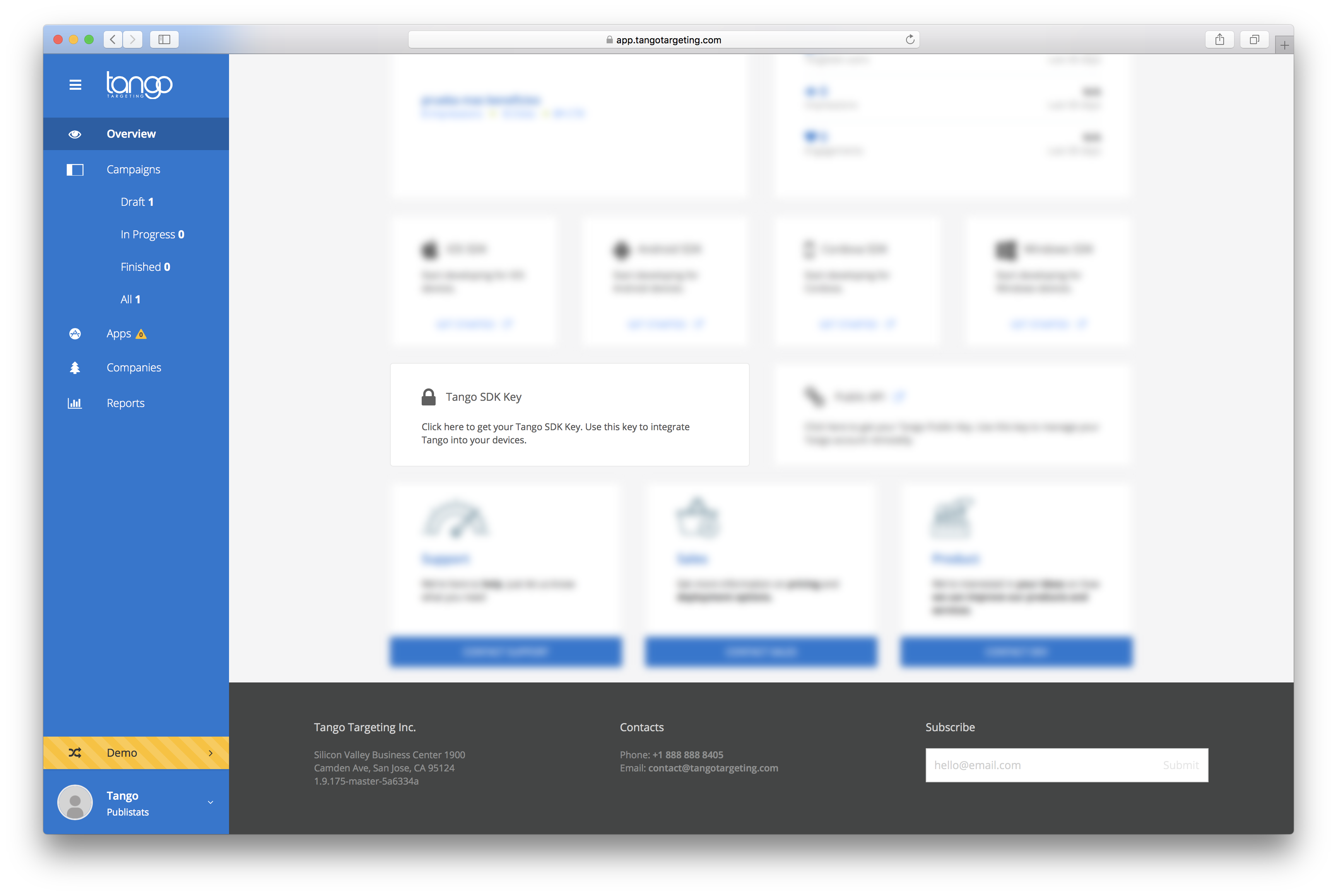Prepare and initialize
Please follow the steps bellow to integrate Tango into your project:
Tango framework¶
Open your project's AppDelegate file and import the Tango framework.
import Tango import UserNotifications
#import <Tango/Tango-Swift.h> #import <Tango/Tango.h> #import <UserNotifications/UserNotifications.h>
The UNUserNotificationCenterDelegate protocol defines methods for responding to actionable notifications. So, to respond to the action, let’s have AppDelegate implement the UNUserNotificationCenterDelegate protocol:
class AppDelegate: UIResponder, UIApplicationDelegate, UNUserNotificationCenterDelegate {}
@interface AppDelegate : UIResponder <UIApplicationDelegate, UNUserNotificationCenterDelegate>
In the didFinishLaunchingWithOptions, setup notification delegate and initialize the Tango Targeting SDK with your Tango SDK key by calling Tango.initialize().
UNUserNotificationCenter.current().delegate = self // Initialize with API key Tango.initialize(tango: "your-tango-sdk-key")
UNUserNotificationCenter *center = [UNUserNotificationCenter currentNotificationCenter]; center.delegate = self; [Tango initializeWithTango:@"your-tango-sdk-key"];
Important
To find your Tango API KEY Go to Console and locate the card Tango SDK Key, then hover it and click the copy icon on the right side.

After that you should implement the following delegate methods.
func application(_ application: UIApplication, didReceiveRemoteNotification userInfo: [AnyHashable : Any], fetchCompletionHandler completionHandler: @escaping (UIBackgroundFetchResult) -> Void) { Tango.application(application, didReceiveRemoteNotification: userInfo) } func application(_ application: UIApplication, didRegisterForRemoteNotificationsWithDeviceToken deviceToken: Data) { Tango.application(application, didRegisterForRemoteNotificationsWithDeviceToken: deviceToken) } func application(_ application: UIApplication, didFailToRegisterForRemoteNotificationsWithError error: Error) { Tango.application(application, didFailToRegisterForRemoteNotificationsWithError: error) } func application(_ application: UIApplication, didReceiveRemoteNotification userInfo: [AnyHashable : Any]) { Tango.application(application, didReceiveRemoteNotification: userInfo) } func application(_ application: UIApplication, didRegister notificationSettings: UIUserNotificationSettings) { Tango.application(application, didRegister: notificationSettings) } func application(_ application: UIApplication, didReceive notification: UILocalNotification) { Tango.application(application, didReceive: notification) }
- (void)application:(UIApplication *)application didReceiveRemoteNotification:(nonnull NSDictionary *)userInfo { [Tango application:application didReceiveRemoteNotification:userInfo]; } - (void)application:(UIApplication *)application didRegisterForRemoteNotificationsWithDeviceToken:(nonnull NSData *)deviceToken { [Tango application:application didRegisterForRemoteNotificationsWithDeviceToken:deviceToken]; } - (void)application:(UIApplication *)application didFailToRegisterForRemoteNotificationsWithError:(nonnull NSError *)error { [Tango application:application didFailToRegisterForRemoteNotificationsWithError:error]; } - (void)application:(UIApplication *)application didReceiveRemoteNotification:(nonnull NSDictionary *)userInfo fetchCompletionHandler:(nonnull void (^)(UIBackgroundFetchResult))completionHandler { [Tango application:application didReceiveRemoteNotification:userInfo]; } - (void)application:(UIApplication *)application didRegisterUserNotificationSettings:(nonnull UIUserNotificationSettings *)notificationSettings { [Tango application:application didRegister:notificationSettings]; } - (void)application:(UIApplication *)application didReceiveLocalNotification:(UILocalNotification *)notification { [Tango application:application didReceive:notification]; }
For iOS 10 you should also add:
// MARK: UNUserNotificationCenterDelegate Methods @available(iOS 10.0, *) func userNotificationCenter(_ center: UNUserNotificationCenter, didReceive response: UNNotificationResponse, withCompletionHandler completionHandler: @escaping () -> Void) { Tango.userNotificationCenter(center, didReceive: response, withCompletionHandler: completionHandler) } @available(iOS 10.0, *) func userNotificationCenter(_ center: UNUserNotificationCenter, willPresent notification: UNNotification, withCompletionHandler completionHandler: @escaping (UNNotificationPresentationOptions) -> Void) { Tango.userNotificationCenter(center, willPresent: notification, withCompletionHandler: completionHandler) }
// MARK: UNUserNotificationCenterDelegate Methods - (void)userNotificationCenter:(UNUserNotificationCenter *)center willPresentNotification:(UNNotification *)notification withCompletionHandler:(void (^)(UNNotificationPresentationOptions options))completionHandler { [Tango userNotificationCenter:center willPresent:notification withCompletionHandler:completionHandler]; } - (void)userNotificationCenter:(UNUserNotificationCenter *)center didReceiveNotificationResponse:(UNNotificationResponse *)response withCompletionHandler:(void(^)(void))completionHandler { [Tango userNotificationCenter:center didReceive:response withCompletionHandler:completionHandler]; }
Location tracking
If you are going to use a location campaign you need to add in your plist the following key: NSLocationAlwaysUsageDescription.